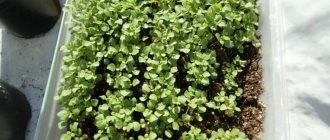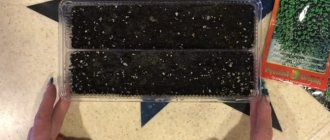If you want to give the area a unique flavor, then plant mallow, which is great for growing from seeds at home.
Dear readers! For you, we have created communities on social networks in which useful articles and interesting ideas are published several times a day! Subscribe and receive useful content in a convenient format!
This is an unpretentious plant, which is also called rose stem.
Mallow (rose rose) is propagated with seeds. They are sown in two ways: seedlings and direct application to the soil. If you follow the technology, the mallow will delight you with flowering in just a few months.
How to determine the time of sowing mallow?
To grow annual stock roses, sowing is carried out from late February to mid-March. There is no need to be afraid of cold weather: mallow is not afraid of lower temperatures.
Biennial seeds are sown in the garden bed from April to the end of May. Pre-winter sowing is carried out in the fall, in October. To avoid seed death, sowing is carried out in October. With spring warming, seeds sown on the eve of winter germinate.
ATTENTION! The flowering of the rose stem depends on the timing of sowing. Bushes grown at home from seedlings will delight the eye already in September. Plants that were planted in the ground in May will produce flower stalks the following year.
The easiest way to reproduce
Typically, gardeners remove the mallow inflorescences when it has finished blooming. If you don’t want to sow in the ground or grow seedlings, you can leave a few flower stalks so that the seeds can be sown. Only the strongest plants will sprout in spring. They can be used by transplanting them to the right place as soon as they form a second true leaf. Such plants will bloom in the year of planting. This method is not suitable only for double flowers. Seedlings obtained as a result of self-seeding usually do not retain terry.
How to prepare mallow seeds for sowing
To increase germination, growing from seeds at home requires preliminary preparation of planting material.
Round seeds purchased in a store or separated from achenes are placed in warm water at 45 ºC and left for 12 hours. The seeds are covered with a hard, leathery shell that softens when soaked. This manipulation shortens the period of germination of mallow seeds.
ON A NOTE. When growing, it is advisable to use solutions of growth stimulants Epin, Energen and Fitosporin. Substances accelerate the development of seeds, promote better rooting of seedlings during picking, strengthen the immune system and protect against diseases.
To prepare a working solution for soaking flower seeds, dissolve 4 drops of Epin in 100 ml of water and leave for 18-20 hours. The seed material is also treated with ash, soda, potassium permanganate, hydrogen peroxide and other disinfectants dissolved in water.
Beneficial features
Today, most gardeners who are interested in how to grow mallow from seeds value the plant solely for its external beauty. But it also has a number of important beneficial properties!
For example, an infusion of leaves and flowers can be used to treat intestinal disorders and stomach inflammation. You can get rid of a spleen tumor by regularly taking hot baths in which mallow leaves are steamed. Quite often they are also part of breastfeeding.
Using a decoction of flowers as a compress or lotion, you can relieve many skin diseases, relieving itching and accelerating the healing of small wounds. This same property was appreciated by cosmetologists - mallow began to be used to prevent pustule rashes, as well as to restore the epidermis. This is not surprising - the petals contain various sugars, carotene and vitamin C. An additional advantage is that any preparations prepared from the petals and leaves of mallow have absolutely no side effects and are devoid of any contraindications, unlike most drugs, manufactured by modern pharmacologists.
The roots should also not be thrown away - a decoction of them has expectorant and anti-inflammatory properties and can help with inflammation of the gastrointestinal tract, diseases of the cardiovascular system and respiratory tract.
When to sow mallow for seedlings in 2022 according to the Lunar calendar?
The right thing is done by flower growers who, when growing at home, check the timing of sowing crops with the dates indicated in the Lunar calendar. The energy of suitable/unsuitable days affects the germination and development of stock rose seedlings.
Favorable days for sowing mallow in 2022 (by month)
| In January | In February | In March | In April | In May | In June | |
| Preparation/Soaking | 21, 22, 26, 27 | from 12 to 14, 17-24 | 12-14,17, 18, 23-24 | 18-19, 26-28 | 20, 22, 24, 25 | 21, 22, 23, 29-30 |
| Sowing | 3-9, 16-17, 20-23, 25-27, 30-31 | 4, 7-9, 12-14, 7-25 | 3, 5, 8, 14-22, 24-27 | 3, 5, 8-9, 13, 15-22, 24-26 | 2, 5-7, 12-17, 19-22, 24, 25, 28 and 29 | 2, 3, 6-8, 15-26, 29, 30 |
| Picking / Transplanting | 5-9, 16-17, 21-23, 25-27 | 2-5, 7-9, 20-24 | 1, 3-5, 8, 15, 19 and 28 | 1, 3, 5, 8, 9, 13, 15-19, 28 | 1, 2, 5, 13, 15, 16,17, 20, 24, 28-29 | 2-3, 6-8, 11-13, 6, 21-23, 29-30 |
Bad days to plant mallow seeds in 2021
| In January | In February | In March | In April | In May | In June | |
| Do not carry out cultivation robots | 2, 3, 10, 13-15, 28 and 31 | 10, 11, 21, 22, 26 and 27 | 9-11, 13, 19-21, 25, 26, 28 | 3-4, 12, 15-17, 20-22, 27 and 30 | 3, 4, 8-9, 11, 24, 30 and 31 | 1, 4-5, 10, 14-15, 24, 27-28 |
Propagation by dividing the bush
How indoor ivy or hedera propagates
Experienced gardeners recommend using this method only for two-year-old flowers. It is very difficult to propagate mallow by perennial division without damaging the root system. In most cases this is not recommended. A highly branched root system may not survive transplantation and division.
Bush division scheme
In the first year after planting, it is much safer to propagate mallow by dividing the bush. The root is carefully dug up and separated. The resulting cuttings are planted on the site.
When to plant depending on the region?
Mallow is cultivated in Russia, Ukraine and Uzbekistan. As a medicinal, fodder and ornamental plant, mallow is grown in areas with warm and cold climates, as well as in the central zone.
Mid latitudes
In the middle zone, stock roses are planted in open ground in spring and autumn. To preserve flowers, they are covered in a greenhouse, placed in a cellar or in cold storage. These measures will help the mallow to safely survive the frosts.
Southern regions
Given the cold-resistant characteristics of the flower, during the winter months it is left to overwinter in the garden bed. In October-November, a mulch layer is laid at the base. This is enough for crops growing in warm areas.
North
Residents of the region have to give up growing mallow. In the harsh northern climate, it loses its winter hardiness. But some species adapt and grow in cold conditions with additional shelter and insulation. You can use spruce branches, spunbond, film or agrofibre. These measures will protect the mallow and help it survive the cold.
Characteristics of the flower and its features
Málva is a herbaceous plant, the stem of which can be either ascending or lying 30-130 cm long, while there are hybrid varieties up to two meters long.
Main features of the plant:
- the stem of this crop is juicy, not smooth, a little dry;
- the leaves are heart-shaped and covered with a soft edge;
- 1-5 flowers grow on one plant.
Depending on the variety and weather conditions, mallow blooms from early June to late September.
Planting mallow seeds step by step
When growing at home using seedlings, prepare a container (container, tray, plastic cups) and fill it with nutritious soil mixture. Add a universal flower substrate, sand, and Vermiculite.
You can use a mixture of coconut substrate, organic matter (humus collected in the fall), ash, or plant it in peat pots.
Mallow seeds are large and are easy to distribute over the soil surface. The contents of the container are leveled and slightly compacted. This is done so that there are no voids in the ground and the seeds do not fall deeper than they should.
Next, the sowing is carried out step by step:
- The earth is warmed up and disinfected.
- Moisten generously with a spray bottle. The water should be warm, so the seed will germinate faster.
- The mallow seed material is laid out on the surface of the soil, pressing lightly with your fingers. Seeds need deeper planting (1.5-2 cm).
- The seeds are covered with a layer of soil mixture on top, covered with a lid or film in order to create a microclimate and a greenhouse effect in the tray.
- Place in a warm, bright place with an optimal temperature of 20-23 C, leave for germination.
If the air in the room is heated to 18-22 ºС, it will take about 2 weeks for germination at home. In a cool apartment, the trays are watered with hot water, then covered with thick canvas or a blanket and kept until the seeds hatch.
There are other ways to grow mallow seeds at home. Savvy gardeners have come up with an alternative technique. Its peculiarity is that the seeds germinate not in the soil, but on a damp sponge without a soil environment. After some time, the seeds that have the beginnings of roots are placed in a pot. Place in a warm, dark place and wrap up.
Unsprouted specimens are thrown away. This simplest technique allows you to get rid of non-viable empty seeds. Only those specimens that have opened and formed a root are placed in the soil mixture. Mallow crops are placed on a radiator, which makes it possible to obtain seedlings in a short time.
PECULIARITY! Plants are planted in groups, so it makes sense to put 3-5 seeds in a jar or glass, and then simply roll them over with the ground without damaging the thread-like roots.
Description of the plant
Mallows are native to central and Western Asia and are found wild in the Balkans and southern Russia. Numerous varieties and hybrids obtained by crossing wild species are grown in culture.
Their height ranges from the very small Majorette Mixed, which does not grow above 80 cm, to the giant Powder Puffs Mixed, whose height is 2 m. All mallows have erect stems, initially pubescent and then bare; one bush can produce up to 15 shoots. Characteristic of mallow are large alternate leaves with long petioles, also pubescent. Their shape is varied and can be rounded heart-shaped or have up to 7 lobes. Flowers numbering from 1 to 5 are formed in the axils of the leaves. They have a fused base and a split top. The flower diameter ranges from 5 to 15 cm. There are many interesting forms with double flowers. The color palette of mallows is very diverse and includes almost all colors and shades. Flowers are usually collected in a brush; there can be up to 150 of them.
For the most part, hollyhocks are perennials or biennials. There are much fewer annual plants among them.
Important! Mallow is a medicinal plant and is used in folk medicine as an expectorant.
How to care for mallow seedlings, any tricks?
Experienced amateur gardeners are ready to share their secrets for caring for mallow and its seedlings at home.
The mallow seeds have sprouted, what to do next?
A week after sowing, the disc-shaped mallow seeds hatch and germinate. Now they need sunlight (additional illumination by a lamp), watering and temperature control (from 20 to 23 ºС). In a month and a half, the seedlings will get stronger and grow.
The next important point when growing rose stems at home is picking. It is started when two true sheets appear. There is no need to rush when planting mallow seedlings in a permanent place. Return frosts can damage it.
How to feed flower seedlings
Picked ornamental plants are fed after they become stronger, otherwise they can be damaged. It is advisable to start feeding the bushes no earlier than in a week.
If the soil is fertile and filled with nutrients, it is enough to feed the mallow once with complex mineral fertilizer according to the instructions.
Repeated feeding of mallow is carried out during the period of preparation for flowering. Having noticed flower stalks (around June), potassium-phosphorus fertilizers are applied.
Plant picking rules
After waiting for the heat to settle, you can begin diving. If mallow seedlings grew in individual containers or cassettes, they are handled with a clod of earth, practically without injuring the root.
If the seedlings were grown in a common tray, the soil should first be moistened so as not to damage the root. Next, everything is done step by step in accordance with the mini-instructions:
- Turn the container over, carefully remove the seedlings and very carefully separate the seedlings from each other. An accidentally torn piece of root will not cause much damage: the cells of the root system are activated, and the root will become more powerful.
- In the ground on the territory of the garden bed, depressions are made into which the formed rosettes of mallow are placed.
- The ground around the plants is pressed down and mulched with rotted sawdust, straw, hay, humus, etc.
Water and leave. Further care for hollyhocks consists of regular weeding and loosening.
Is it possible to immediately sow seeds in open ground?
Planting mallow seeds in open ground eliminates the hassle with seedlings. If you don’t want to see flowers this year, then sowing seedlings can be ignored. Using the seedless method, seed material is introduced into open ground. This is done no earlier than in May-June.
Later, rosettes of leaves are formed, they grow and turn green all summer until the onset of winter. But the lush rocking inflorescences of the mallow bloom only the next year. This method has one advantage: the flower stalks are rich and luxurious.
In order for the annual mallow to throw out its color by the summer of the first year, it makes no sense to add seeds directly to the garden bed: the soil is not ready, the seeds will not sprout. For this, there is a seedling method for growing at home.
Judging by the observations of flower growers, when grown at home by seedlings (spring planting), the plant forms one, not very lush peduncle. Therefore, summer planting is more preferable for lovers of beautiful mallow, and there will be more stems on the plant. You can sow a stock rose in a garden bed before winter.
The seeds are kept under the snow until spring. Planting in the fall has several advantages: simplicity, early summer flowering. The introduction of seeds into the soil is accompanied by further mulching. Features of care include covering with jars for protection from frost and measures against rotting during the thaw.
When to plant seedlings in open ground?
Annual mallow is moved to open ground in mid-May, when the threat of return spring frosts has passed. But cold snaps are not scary for young bushes either: the perennial is a cold-resistant crop. The time for planting comes in August-September.
Possible problems during cultivation
Aphids and spider mites are the most common threats to flowering crops. If pests are detected, the flower must be treated with an insecticide. As for diseases, powdery mildew may appear. A fungicidal solution can help here.
If a plant becomes infected with leaf rust, unfortunately, it will not be possible to restore the affected areas. Leaves with unsightly spots should be torn off and burned. Otherwise, the disease will spread and the mallow will die. To maintain immunity, the culture is treated with Bordeaux mixture. Colloidal sulfur will also work.
When the flowering of the diseased plant ends, it is cut off at the root and burned completely. The area where the flower grew is considered unsuitable for planting a new mallow for another 3 years after the unpleasant situation.
Next, watch a video with expert advice on growing and caring for hollyhocks.
Where is the best place to plant flowers?
Picturesque flowers grow well in flower beds and look great as a hedge. They are planted mainly in groups in the garden. Ridges exposed to the winds are not suitable for hollyhocks.
Tall stems need support. They require tying, otherwise they may break in gusts of wind. It’s good if it is possible to secure the hollyhocks on stakes.
Ideally, hollyhocks are planted in an area along fences. The fence performs a 2 in 1 function: it defines the territory and is used as a trellis for tall hollyhocks. There is an opinion that it is contraindicated for hollyhocks to be near a metal fence due to rust damage. But this is a myth: the underside of the leaves is occupied by the fungus that causes the disease.
Application
Mallow looks great in group plantings, as well as in mixed borders, near fences and hedges, in the background and as a dominant feature in the middle of a flower bed. It is especially attractive in country style gardens; its combination with flowers such as monarda, lupine, delphinium, phlox, and cornflower makes the garden unique and mysterious. It complements compositions of coniferous plants and at the same time is great as a separate accent.
This tall and strong plant culture, which has a lot of advantages, should settle in every garden. Her joyful, bright “bouquets” of flowers will decorate the simplest area, turning it into a fairy-tale garden where elves live.
How to care for mallow in open ground
When the mallows kept in a container at home have formed three leaves, they should be thinned out with indentations of 2-3 cm. The grown, strengthened rosettes are gradually accustomed to other conditions.
Mallow seedlings are hardened off outdoors for several hours. The bushes should be moved to a permanent place from May to June, placing groups of seedlings at a distance of 25 to 50 cm. The row spacing is mulched and regularly moistened.
Watering is accompanied by loosening and removing weeds. During the budding period, mallows are fed with complex fertilizers with a predominance of nitrogen. For the sake of intensive flowering, dried buds are removed.
NOTE! Mallow that has been growing for a year can be turned into a perennial. To do this, after flowering, cut off all flower stalks.
Aftercare
Mallow gained its recognition due to its unpretentiousness and undemanding nature. It is important to water the flower in a timely and systematic manner. After each moistening, the soil must be loosened and cleared of weeds. At the moment of bud formation, fertilizer with a high nitrogen content and complex mineral fertilizers are added to the soil.
Tall varieties of mallow need to be tied up using homemade supports that will support the plant during strong winds.
Plant garter methods
In the fall, after flowering has ended, the plant is sanitary pruned down to ground level. At the same time, it needs to be fed for better adaptation. To do this, add any complex nutritious fertilizer to the soil and cover it with a thick layer of hay or finely chopped branches.
Important! All inflorescences must be removed after the end of the flowering period.
What conditions are needed in open ground?
The soil on the site should be loose, light and fertile, with an admixture of sand. The clay structure is not suitable for the growth of mallow. If the land is depleted, it is enriched before planting or mulched with rotted manure.
The beds should not have lowlands or depressions in which water usually accumulates and stagnates. It has a detrimental effect on the plant. Light-loving mallow tolerates shade, but the petals may lose their brightness. It is good if the plot is inaccessible to winds and drafts.
How to water a plant
In hot weather the flower feels fine. Water it not very often, but abundantly. It is better to do this early in the morning or in the evening, using water heated in the sun. You should not overwater young sprouts; they do not like excess moisture.
In dry, hot weather, flowering hollyhocks require abundant watering. It must be remembered that waterlogging is undesirable: stagnation of water is detrimental to the rose stem. Weeding and loosening - this is the minimum that mallow needs.
Features of flower feeding
The beauty and luxurious appearance of mallow depends on a sufficient amount of nutrients in the soil. The effect of nitrogen-containing fertilizers affects the growth rate of mallow, its development and resistance to disease.
To form full buds and abundant flowering, mallows require complex fertilizer. Additionally, mallows need to be fed with weak solutions of potassium and phosphorus. Weak solutions of elements are used from the beginning of summer and processed once every 3-4 weeks.
Types of hollyhock roses
Perennial hollyhocks have five species, which are the most popular:
- Musk stock rose. Pleasantly smelling white or pink flowers adorn the plant, reaching a height of 1 m. Abundant flowering begins in May and continues until frost.
- Sudanese mallow. Flower growers and summer residents grow this species as a biennial. The plant is found in the form of a shrub or small tree. The flowering is abundant and beautiful, the fruits have useful qualities.
- Wrinkled hollyhock rose. A flowering plant that grows up to 1.5 m. Lemon-yellow petals are only 3 cm long. Garden varieties sometimes grow up to 2.5 meters.
- Hybrid mallow. Usually the plant throws out 3-4 flower-bearing arrows, which are then covered with large flowers. The height of the bush is up to 2 meters. There are species with a variety of shades. Flowering is abundant and continues until September.
- Tree mallow. The height of the plant reaches three meters. Grow as a bush or tree. The petals of the flower are purple, white or lilac in color. Blooms from June to September.
Varieties of annuals:
- Zebrina. The plant is distinguished by large pinkish flowers with reddish stripes on the petals.
- Black mother of pearl. The purple petals have black stripes. The flowers are large, bloom abundantly, and continue until the onset of cold weather.
In gardens and parks you can find common mallow. The color palette of the variety is varied: from white tones to bright cherry, almost black. The flowers are bell-shaped and up to 13 cm in size. The height of the plant reaches 2 meters. It is a perennial and will bloom profusely only in the 2nd year after planting.
Interesting Facts
Since ancient times, magical properties have been attributed to this flower. Therefore, they planted her at the gate, near the well, near the fence. The ancestors believed that she protected the farmstead, the home and the people in it.
Mallow is a close relative of the medicinal marshmallow, which treats coughs, inflammation, relieves pain, and is used to remove kidney stones.
Decades ago, children playing in the yard would pluck the green buds from the mallow stems and chew them. Scientists have long proven that rose stock has high feeding qualities. Mallow has more protein than soybeans.
Sowing work - step-by-step instructions
How to properly plant mallow seeds for seedlings:
- a drainage layer 1-2 cm thick (expanded clay or perlite) is placed on the bottom of the container;
- the container is filled with the prepared substrate;
- seeds are laid out at a distance of 5 centimeters from each other;
- sprinkle with earth 1 cm thick;
- Spray generously with warm water from a spray bottle.
It is convenient to sow mallow in individual pots. 2 seeds are planted in each container. This technique achieves an increase in germination by 50%. When the seeds sprout, one of the sprouts (the weakest) is removed.
The container for sowing must have drainage holes. Stagnation of moisture is detrimental to mallow. She can easily become infected with a fungus and die.
Answers to frequently asked questions
Why are the seedlings not friendly, some of the seeds have sprouted, others continue to sprout?
The problem is a poorly prepared soil mixture. It needed to be steamed and the seeds soaked. In addition, seedlings need warmth.
Why do seedlings droop and fall?
This happens due to thickening. Young sprouts fight for a place under the sun (or lamp). The cause is eliminated by thinning, but the stems are not pulled out, but pinched at the soil level.
Why do the sprouts stretch out?
They become thinner and lean to the sides. The reason is insufficient lighting, too warm a room and waterlogging of the soil. To correct the situation, the seedlings are switched to infrequent watering (once every 3-4 days) and make sure that the water is warm (from +18 to +20°C).
Why do mallow seedlings wither and die?
Due to the dry soil, they receive little moisture. Wilting begins with the lower pair of leaves. Their curling indicates the presence of fungal spores or pests.
The main thing is to notice the disorder, eliminate the cause in time and provide the flowers with proper care. And they will reward you with beauty that is pleasing to the eye.
Choosing a suitable location
Over time, you will have to plant the seedlings outside. And to do this, you need to decide in advance where exactly the mallow will grow.
For planting, it is better to choose a place that is clearly visible from anywhere in the yard. What's the point of a beautiful plant if you can't really see it? It is worth remembering that generally mallow has rather long stems - more than a meter. A gust of strong wind may well break it. To prevent this from happening, it is advisable to either protect the plant from the wind or install a special fence to support the stems. But the easiest way is to plant mallow near the fence so that the wind does not cause unnecessary trouble.
In this case, it is best to plant flowers on the south side of the fence or at least on the west side. Then the plant will receive a lot of sunny color - this is very important for mallow. And protection from cold winds from the north and east will not be superfluous, especially in the first stages of life, while the plant is not strong enough. If the mallow does not receive enough light, then the flowers on it will not be too bright, which is unlikely to please the gardener.











